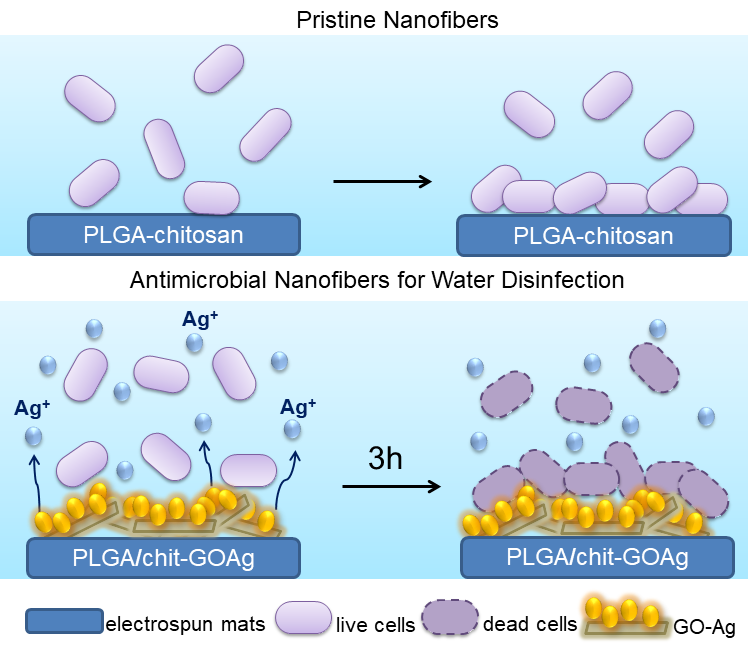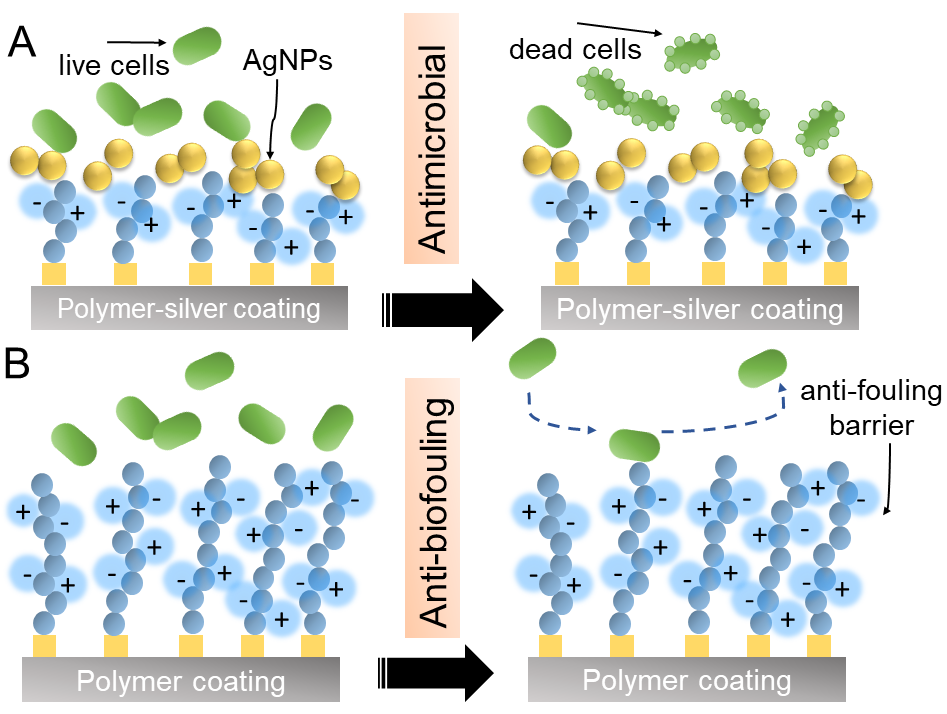My research interests are in the application of nanotechnology to improve water quality and water treatment. Nano-based materials can be designed to work as new adsorbents, membranes for water filtration, and antimicrobial agents for water disinfection. In addition to the application of nanomaterials, our research group also want to understand the factors affecting the toxicity of nanomaterials to the environment (e.g., water and soil ecosystems). With the support of advanced biological and analytical techniques, our group investigates how changes in the chemical and physical nature of nanomaterials affect their interaction with microorganisms and its behavior in natural environments.
Some Topics of Interest Are:
 NANO-BASED MATERIALS FOR WATER DISINFECTION AND SANITATION: conventional methods for water disinfection, such as the use of free chlorine, are efficient in killing bacteria but they also introduce toxic by-products into the water. New technologies and materials can provide bacterial inactivation without adding harmful compounds to water supplies. For example, nanomaterials have an exceptional ability to control microbial proliferation in water without the production of toxic secondary compounds. However, fast dissolution and release of nanomaterials into aquatic environments limit the implementation of nano-based technologies for water treatment. The goal is to create hybrid nano-based materials that can inactivate target microorganisms in water while presenting low dissolution and release in water ecosystems. Along with proper sanitation practices, the use of antimicrobial nano-based materials can help to increase safe drinkable water supplies through the use of unconventional water sources, particularly in areas where centralized water treatment systems are nonexistent.
NANO-BASED MATERIALS FOR WATER DISINFECTION AND SANITATION: conventional methods for water disinfection, such as the use of free chlorine, are efficient in killing bacteria but they also introduce toxic by-products into the water. New technologies and materials can provide bacterial inactivation without adding harmful compounds to water supplies. For example, nanomaterials have an exceptional ability to control microbial proliferation in water without the production of toxic secondary compounds. However, fast dissolution and release of nanomaterials into aquatic environments limit the implementation of nano-based technologies for water treatment. The goal is to create hybrid nano-based materials that can inactivate target microorganisms in water while presenting low dissolution and release in water ecosystems. Along with proper sanitation practices, the use of antimicrobial nano-based materials can help to increase safe drinkable water supplies through the use of unconventional water sources, particularly in areas where centralized water treatment systems are nonexistent.
PHYSICOCHEMICAL PROPERTIES AFFECT THE ANTIMICROBIAL PROPERTIES OF NANOMATERIALS: size, aggregation state, oxidation level, and surface functionalization have been found to affect the antimicrobial properties of nanomaterials. However, the relationship between the physicochemical properties of nanomaterials and their cytotoxicity is not well understood. Identifying how physicochemical properties influencing the cytotoxicity and the mechanism of toxicity will allow us to design antimicrobial nanomaterials with maximum applicability and minimum aquatic toxicity. We will focus our interest on carbon nanomaterials, metallic, and metal oxide particles. Surface functionalization will be performed to intensify or incorporate antimicrobial properties to the nanomaterials.
 ANTIMICROBIAL AND ANTI-ADHESION COATINGS FOR BIOFILM CONTROL: cell adhesion is the most decisive step in biofilm formation. By controlling the surface properties, therefore, it is possible to change the affinity between bacterial cells and the surface, thus inactivating the bacteria or preventing them from sticking to the substrate. In this context, the development of antimicrobial or anti-adhesion coatings is a suitable approach to reduce biofilm growth. We aim to develop coated surfaces with the ability to mitigate bacterial adhesion and biofilm formation. The anti-fouling coating can be achieved by modifying model surfaces with nanomaterials and hydrophilic polymers using well-established techniques such as layer-by-layer, self-assembly, spin coating, or chemical surface binding.
ANTIMICROBIAL AND ANTI-ADHESION COATINGS FOR BIOFILM CONTROL: cell adhesion is the most decisive step in biofilm formation. By controlling the surface properties, therefore, it is possible to change the affinity between bacterial cells and the surface, thus inactivating the bacteria or preventing them from sticking to the substrate. In this context, the development of antimicrobial or anti-adhesion coatings is a suitable approach to reduce biofilm growth. We aim to develop coated surfaces with the ability to mitigate bacterial adhesion and biofilm formation. The anti-fouling coating can be achieved by modifying model surfaces with nanomaterials and hydrophilic polymers using well-established techniques such as layer-by-layer, self-assembly, spin coating, or chemical surface binding.
 ANTI-FOULING STRATEGIES FOR IMPROVED WATER TREATMENT MEMBRANES: promoting access to safe and clean water is one of the biggest challenges of this century. Membrane-driven processes have been used to increase the production of potable water. However, the performance of these technologies is often affected by the attachment of organic materials, inorganic particles, and microorganisms. Development of novel materials, therefore, is of critical importance to advance membrane-based water treatment technologies and to meet the requirements for clean water production. By taking advantage of the membrane surface chemistry, nanomaterials and polymeric substances can be immobilized to the membrane, imparting both anti-biofouling and anti-fouling properties. These strategies can help mitigate the adverse effects of fouling, increasing the membrane life-cycle and helping to decrease costs associated with maintenance.
ANTI-FOULING STRATEGIES FOR IMPROVED WATER TREATMENT MEMBRANES: promoting access to safe and clean water is one of the biggest challenges of this century. Membrane-driven processes have been used to increase the production of potable water. However, the performance of these technologies is often affected by the attachment of organic materials, inorganic particles, and microorganisms. Development of novel materials, therefore, is of critical importance to advance membrane-based water treatment technologies and to meet the requirements for clean water production. By taking advantage of the membrane surface chemistry, nanomaterials and polymeric substances can be immobilized to the membrane, imparting both anti-biofouling and anti-fouling properties. These strategies can help mitigate the adverse effects of fouling, increasing the membrane life-cycle and helping to decrease costs associated with maintenance.
NEXT GENERATION ADSORBENTS FOR SUSTAINABLE WATER DECONTAMINATION: the use of adsorbents is a fast and cost-effective approach for removal of contaminants from water. However, standard adsorbents have limitations related to their structure and chemical composition, surface area, and regeneration/reuse properties. One approach to increase adsorption capacity is the combination of conventional nanoadsorbents (alumina, iron and titanium oxide particles) with carbon nanomaterials, while improvements in separation and regeneration rates are achievable through the use of polymeric materials. Our goal is to develop nano-based composites to act as adsorbents for water as wastewater decontamination that easy to recover and reuse.
 ULTRASENTIVE AND SELECTIVE SENSORS FOR WATER QUALITY MONITORING: the presence of contaminants in water supplies has increased as a function of population growth, intense industrial and agricultural activities, and deliberate disposal of wastewaters in freshwater resources. The contamination of drinking water with personal care compounds (PCCs), polychlorinated biphenyl (PCBs), and heavy metals can negatively affect human and environmental health. Although awareness regarding the presence of these pollutants in drinking water has increased, accurate detection of contaminants in water is still limited by the lack of sensitivity and specificity of current analytical techniques. The development of analytical devices that allow sensitive and selective detection of contaminants is still needed. The goal of this research line is to develop nano-based sensors to control water quality and improve the detection of micro-pollutants in water.
ULTRASENTIVE AND SELECTIVE SENSORS FOR WATER QUALITY MONITORING: the presence of contaminants in water supplies has increased as a function of population growth, intense industrial and agricultural activities, and deliberate disposal of wastewaters in freshwater resources. The contamination of drinking water with personal care compounds (PCCs), polychlorinated biphenyl (PCBs), and heavy metals can negatively affect human and environmental health. Although awareness regarding the presence of these pollutants in drinking water has increased, accurate detection of contaminants in water is still limited by the lack of sensitivity and specificity of current analytical techniques. The development of analytical devices that allow sensitive and selective detection of contaminants is still needed. The goal of this research line is to develop nano-based sensors to control water quality and improve the detection of micro-pollutants in water.